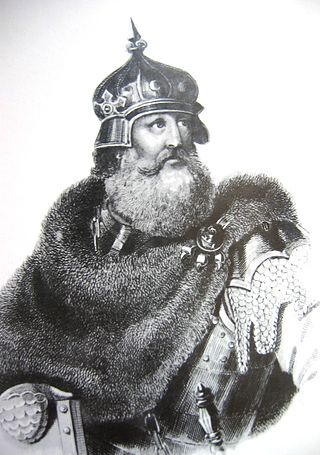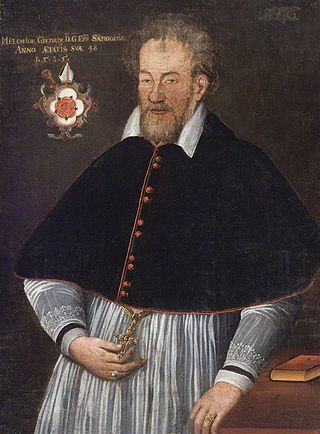
Jogaila, later Władysław II Jagiełło, was Grand Duke of Lithuania, later giving the position to his cousin Vytautas in exchange for the title of Supreme Duke of Lithuania (1401–1434) and then King of Poland (1386–1434), first alongside his wife Jadwiga until 1399, and then sole ruler of Poland. Raised a Lithuanian polytheist, he converted to Catholicism in 1386 and was baptized as Ladislaus in Kraków, married the young Queen Jadwiga, and was crowned King of Poland as Władysław II Jagiełło. In 1387, he converted Lithuania to Catholicism. His own reign in Poland started in 1399, upon the death of Queen Jadwiga, lasted a further thirty-five years, and laid the foundation for the centuries-long Polish–Lithuanian union. He was a member of the Jagiellonian dynasty in Poland that bears his name and was previously also known as the Gediminid dynasty in the Grand Duchy of Lithuania. The dynasty ruled both states until 1572, and became one of the most influential dynasties in late medieval and early modern Europe.

Vytautas, also known as Vytautas the Great, was a ruler of the Grand Duchy of Lithuania. He was also the prince of Grodno (1370–1382), prince of Lutsk (1387–1389), and the postulated king of the Hussites.

Aukštaitija is the name of one of five ethnographic regions of Lithuania. The name comes from the fact that the lands are in the upper basin of the Nemunas, as opposed to the Lowlands that begin from Šiauliai westward. Although Kaunas is surrounded by Aukštaitija, the city itself is not considered to be a part of any ethnographic region in most cases.

Kęstutis was the Grand Duke of Lithuania. He was the Duke of Trakai and governed the Grand Duchy of Lithuania, 1342–1382, together with his brother Algirdas, and with his nephew Jogaila.

The Duchy of Samogitia was an administrative unit of the Grand Duchy of Lithuania from 1422. Between 1422 and 1441 it was known as the Eldership of Samogitia. Since the 1540s the Grand Duke of Lithuania also held the title of Duke of Samogitia, although the actual ruler of the province, responsible to the Grand Duke, was known as the General Elder of Samogitia who was self-elected by the Samogitian nobility.

The Catholic Church in Lithuania is part of the worldwide Catholic Church, under the spiritual leadership of the Pope in Rome. Lithuania is the world's northernmost Catholic majority country. Pope Pius XII gave Lithuania the title of "northernmost outpost of Catholicism in Europe" in 1939. The Vilnius Cathedral is the most important Catholic Church in Lithuania, which was previously used for the inauguration ceremonies of Lithuanian monarchs with Gediminas' Cap, while in modern times it is a venue for masses dedicated to the elected Presidents of Lithuania after their inauguration ceremonies and giving of oaths to the Nation in the Seimas Palace.

The Treaty of Melno or Treaty of Lake Melno was a peace treaty ending the Gollub War. It was signed on 27 September 1422, between the Teutonic Knights and an alliance of the Kingdom of Poland and the Grand Duchy of Lithuania at Lake Melno, east of Graudenz (Grudziądz). The treaty resolved territorial disputes between the Knights and Lithuania regarding Lithuania Minor and Samogitia, which had dragged on since 1382, and determined the Prussian–Lithuanian border, which afterwards remained unchanged for about 500 years. A portion of the original border survives as a portion of the modern border between the Republic of Lithuania and Kaliningrad Oblast, Russia, making it one of the oldest and most stable borders in Europe.

This is the 1422 Polish-Teutonic War. For a list of all Polish-German Wars, see Polish-German Wars.

Varniai is a city in the Telšiai County, western Lithuania. In the Middle Ages the city was known as Medininkai.
The Lithuanian Council of Lords was the main permanent institution of central government in the Grand Duchy of Lithuania active in its capital city of Vilnius.

The Metropolitan Archdiocese of Kaunas is a Latin Church ecclesiastical territory or archdiocese of the Catholic Church in Lithuania. The episcopal see is in Kaunas, the second-largest city in Lithuania. The archdiocese's motherchurch and cathedral is Kaunas Cathedral Basilica; it is also home to a Minor Basilica in a town of Šiluva, in the region of Samogitia.

The Ostrów or Astrava Agreement was a treaty between Jogaila, King of Poland and Grand Duke of Lithuania, and his cousin Vytautas the Great, signed on 4 August 1392. The treaty ended the destructive Lithuanian Civil War, launched in 1389 by Vytautas who hoped to gain political power, and concluded the power struggle between the two cousins that erupted in 1380 after Jogaila secretly signed the Treaty of Dovydiškės with the Teutonic Knights. The Ostrów Agreement did not stop attacks from the Teutonic Knights and the territorial dispute over Samogitia continued up to 1422. According to the treaty, Vytautas became the ruler of Lithuania, but he also acknowledged Jogaila's rights to Lithuania. The details of the Polish–Lithuanian relationship were clarified in several later treaties, including the Union of Vilnius and Radom in 1401 and Union of Horodło in 1413.

The Treaty of Salynas was a peace treaty signed on 12 October 1398 by Vytautas the Great, the Grand Duke of Lithuania, and Konrad von Jungingen, the Grand Master of the Teutonic Knights. It was signed on an islet of the Neman River, probably between Kulautuva and the mouth of the Nevėžis River. It was the third time, after the Treaty of Königsberg (1384) and Treaty of Lyck (1390), that Vytautas promised Samogitia to the Knights. The territory was important to the Knights as it physically separated the Teutonic Knights in Prussia from its branch in Livonia. It was the first time that the Knights and Vytautas attempted to enforce the cession of Samogitia. However, it did not solve the territorial disputes over Samogitia and they dragged on until the Treaty of Melno in 1422.

The Lithuanian Civil War of 1389–1392 was the second civil conflict between Jogaila, King of Poland and Grand Duke of Lithuania, and his cousin Vytautas. At issue was control of the Grand Duchy of Lithuania, then the largest state in Europe. Jogaila had been crowned King of Poland in 1386; he installed his brother Skirgaila as ruler of Lithuania. Skirgaila proved unpopular and Vytautas attempted to depose him. When his first attempt to take the capital city of Vilnius failed, Vytautas forged an alliance with the Teutonic Knights, their common enemy – just as both cousins had done during the Lithuanian Civil War between 1381 and 1384. Vytautas and the Knights unsuccessfully besieged Vilnius in 1390. Over the next two years it became clear that neither side could achieve a quick victory, and Jogaila proposed a compromise: Vytautas would become Grand Duke and Jogaila would remain Superior Duke. This proposal was formalized in the Ostrów Agreement of 1392, and Vytautas turned against the Knights. He went on to reign as Grand Duke of Lithuania for 38 years, and the cousins remained at peace.

The Lithuanian Civil War of 1381–1384 was the first struggle for power between the cousins Jogaila, Grand Duke of Lithuania and later King of Poland, and Vytautas the Great. It began after Jogaila signed the Treaty of Dovydiškės with the Teutonic Knights which was aimed against his uncle Kęstutis, father of Vytautas. Kęstutis briefly seized power in the Grand Duchy, but was betrayed by adherents of Jogaila primarily from Vilnius. During negotiations for a truce Kęstutis and Vytautas were arrested and transported to the Kreva Castle. Kęstutis died there a week later but Vytautas managed to escape and then sought an alliance with the Teutonic Knights. Subsequently their joint forces raided Lithuanian lands. Eventually the cousins were reconciled as Jogaila needed internal stability in anticipation of negotiations with the Grand Duchy of Moscow and the Kingdom of Poland regarding the possible Christianization of Lithuania. The war did not settle the power struggle; it continued during the next Lithuanian Civil War (1389–1392) which was resolved by the signing of the Ostrów Agreement. After more than ten years of struggle, Vytautas finally became the Grand Duke of Lithuania and ruled the country for thirty-eight years.
The Treaty of Lyck was a treaty between Vytautas the Great, future Grand Duke of Lithuania, and the Teutonic Knights, represented by Marquard von Salzbach, komtur Arnold von Bürglen, and Thomas, son of Lithuanian duke Survila. It was signed on 19 January 1390 in Lyck, State of the Teutonic Order,. Vytautas, in exchange for a military alliance against his cousin Jogaila during the Lithuanian Civil War (1389–1392), agreed to cede Samogitia up to the Nevėžis River and become the Order's vassal. In essence Vytautas confirmed the Treaty of Königsberg (1384) that he had signed with the Knights during the Lithuanian Civil War (1381–1384). Once betrayed, the Knights now asked for hostages as a guarantee of Vytautas' loyalty. The Order demanded as hostages his two brothers Sigismund and Tautvilas, wife Anna, daughter Sophia, sister Rymgajla, brother-in-law Ivan Olshanski, and a number of other nobles.

Samogitian uprisings refer to two uprisings by the Samogitians against the Teutonic Knights in 1401–1404 and 1409. Samogitia was granted to the Teutonic Knights by Vytautas the Great, Grand Duke of Lithuania, several times in order to enlist Knights' support for his other military affairs. The local population resisted Teutonic rule and asked Vytautas to protect them. The first uprising was unsuccessful and Vytautas had to reconfirm his previous promises to transfer Samogitia in the Peace of Raciąż. The second uprising provoked the Knights to declare war on Poland. Hostilities escalated and resulted in the Battle of Grunwald (1410), one of the biggest battles of medieval Europe. The Knights were soundly defeated by the joint Polish–Lithuanian forces, but Vytautas and Jogaila, King of Poland, were unable to capitalize on their victory. Conflicts regarding Samogitia, both diplomatic and military, dragged until the Treaty of Melno (1422).

Merkelis Giedraitis was Bishop of Samogitia from 1576 to 1609. Educated at Protestant universities in the Duchy of Prussia and Germany, he actively combated the Reformation implementing resolutions of the Council of Trent in Samogitia. Born into the princely Giedraičiai family, he inherited a much neglected diocese that was reduced to only about 20 priests. He became known for his devotion and work to end clerical abuses, strengthen churches and schools, and increase the number of priests. Giedraitis invited the Jesuits to Kražiai where the Kražiai College was established already after his death and the Bernadines to Kretinga where they established the first monastery in Samogitia. He sponsored Mikalojus Daukša, who translated and published Catechism (1595) and Postil (1599) in the Lithuanian language—the first Lithuanian books printed within the Grand Duchy of Lithuania. He also supported Maciej Stryjkowski, author of the first printed history of Lithuania. In recognition of his efforts, Giedraitis is often referred to as the second baptist of Samogitia.

The Christianization of Lithuania occurred in 1387, initiated by King of Poland and Grand Duke of Lithuania Jogaila and his cousin Vytautas the Great. It signified the official adoption of Catholic Christianity by Lithuania, the last pagan country in Europe. This event ended one of the most complicated and lengthiest processes of Christianization in European history.
Jurgis Petkūnas was a Bishop of Samogitia from 1567 to 1574. He received medical education in universities in Germany and Italy. Despite his lack of theological education, Petkūnas was confirmed as bishop in November 1567. He inherited a neglected diocese that had only about 20 priests and faced competition from the Protestants. He was the first Samogitian bishop charged with implementing the Counter-Reformation decisions of the Council of Trent.
















